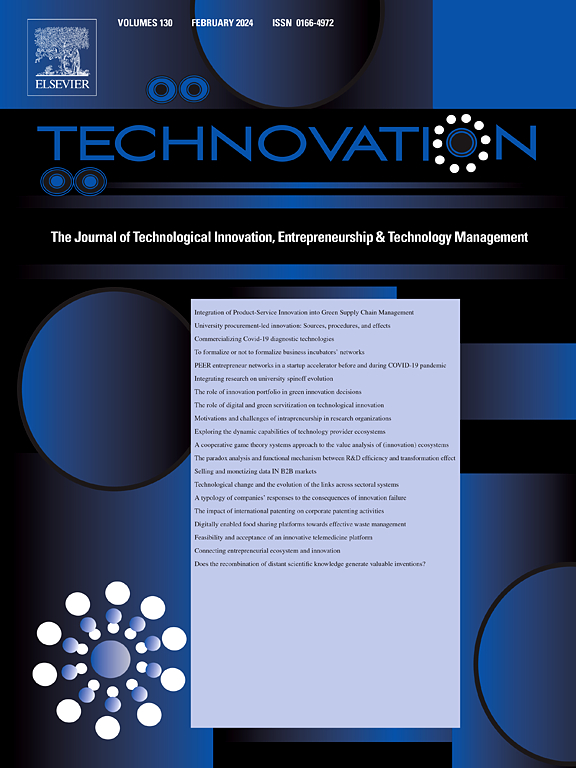Intellectual property governance and academic technology transfer
IF 10.9
1区 管理学
Q1 ENGINEERING, INDUSTRIAL
引用次数: 0
Abstract
The existing literature on IP governance exhibits three notable limitations. First, it predominantly focuses on IP protection and management, while attention to acquisition and service remains limited. Second, few studies have approached the mechanisms through which IP governance exerts influence by considering the distinct elements within innovation system. Third, existing analyses often focus on knowledge production, with insufficient consideration of the subsequent commercialization, especially for academic technology outputs that remain latent. Here, grounded in the activity-process view, this study disaggregates IP governance into distinct modules. Drawing on innovation diffusion theory, it further constructs analytical framework that encompasses nodes, interactive relationships, and environment. Empirically, employing spatial difference-in-differences, the impact of China's National Intellectual Property Rights Demonstration City (NIPRDC) on patents transferred from academia (PTA patents) is assessed. The key findings are as follows: (1) NIPRDC significantly boosts the scale and share of urban PTA patents, with results remaining valid through endogeneity and robustness checks. (2) Causal mediation analysis indicates that the "Interactive relationship" (research collaboration) is the dominant mechanism, contributing 83.6 %. The "Innovator" (university innovation capability) and "Adopter" (enterprise absorption capability) mechanisms follow, with explanatory power ranging from 53.1 % to 62.0 %. The "Environment" mechanism, represented by digitization and IP intermediaries, contributes relatively less, accounting for 11.0 %–28.8 %. (3) The policy effect differs by batch and region, with greater impact in developed, innovative cities, while also triggering spatial spillovers that boost academic technology transfers nearby.
知识产权治理和学术技术转让
现有的知识产权治理文献有三个显著的局限性。首先,它主要侧重于知识产权保护和管理,而对获取和服务的关注仍然有限。其次,很少有研究通过考虑创新体系中不同的要素来探讨知识产权治理发挥影响的机制。第三,现有的分析往往侧重于知识生产,对后续的商业化考虑不足,特别是对学术技术产出的潜在影响。在此,基于活动-过程的观点,本研究将知识产权治理分解为不同的模块。借鉴创新扩散理论,进一步构建了包含节点、互动关系和环境的分析框架。实证研究采用空间差中差的方法,对中国国家知识产权示范城市(NIPRDC)对学术转移专利(PTA专利)的影响进行了评估。研究发现:(1)新规创新中心显著提升了城市PTA专利的规模和份额,且内生性检验和稳健性检验结果仍然有效。(2)因果中介分析表明,“互动关系”(科研合作)是主导机制,贡献率为83.6%。其次是“创新者”机制(大学创新能力)和“采用者”机制(企业吸收能力),解释力在53.1% ~ 62.0%之间。以数字化和知识产权中介为代表的“环境”机制贡献相对较小,占11.0% - 28.8%。(3)政策效应因批次和地区而异,对发达创新型城市的影响更大,同时也会引发空间溢出效应,促进附近地区的学术技术转移。
本文章由计算机程序翻译,如有差异,请以英文原文为准。
求助全文
约1分钟内获得全文
求助全文
来源期刊

Technovation
管理科学-工程:工业
CiteScore
15.10
自引率
11.20%
发文量
208
审稿时长
91 days
期刊介绍:
The interdisciplinary journal Technovation covers various aspects of technological innovation, exploring processes, products, and social impacts. It examines innovation in both process and product realms, including social innovations like regulatory frameworks and non-economic benefits. Topics range from emerging trends and capital for development to managing technology-intensive ventures and innovation in organizations of different sizes. It also discusses organizational structures, investment strategies for science and technology enterprises, and the roles of technological innovators. Additionally, it addresses technology transfer between developing countries and innovation across enterprise, political, and economic systems.
 求助内容:
求助内容: 应助结果提醒方式:
应助结果提醒方式:


